

 |
 |
 |
 |
 |
We are trying to develop a community where photographers can come and discuss nature, wildlife and pet photography related matters. We encourage you to enter the forums to share, make comments or ask questions about this interview or any other content of NWP.
This article is Copyright 2006, James Morrissey, and may not, in part or in whole, be reproduced in any electronic or printed medium without prior permission from the author. The images in this article are the property of Helmi Flick and have been licensed to James Morrissey and the NWP Photo Forum for the purpose of this interview.
Part III: The Shoot
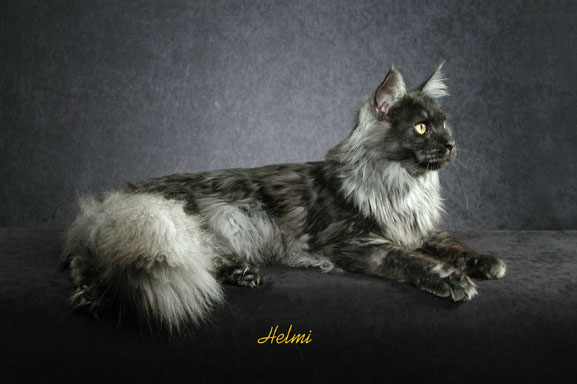
Copyright © Helmi Flick
JM: Is most of your pet photography pet portraiture or is it less formal?
HF: Our work is almost exclusively formal portraiture, which is to say the cats are posed on our shooting stage with a limbo background of various color-coordinated fabrics and shot with studio lighting.
Our objective is to showcase “the cat, the whole cat and,” in most cases, “nothing but the cat” and to do it in a way that is as flattering as possible while revealing all aspects of our subject’s physical appearance. We do this by wrangling each cat into a fairly standard sequence of poses, plus a few others that emphasize its most distinctive or photogenic features and perhaps a few action shots or playful poses that express something of that cat’s personality.
This approach to cat photography is shaped not only by our own esthetic and the style we want to be known for, but also by A) the needs of our customers, the breeders and owners of our subjects which are almost always show cats, and B) the needs of publishers who most often want to buy stock images that accurately depict the look of a particular breed of cat.
There is a market for photos of cats ensconced in an arrangement of fake flowers, lounging in miniature furniture or dressed up in little costumes, but that’s not one we care to pursue. We do have three or four simple props that we occasionally employ to engage the cat or encourage certain, behaviors, poses or interactions. But we try to avoid any look that might be characterized as cutesy, frou-frou, or precious.
JM: For your formal work, do you prefer to do it on location or in your studio?
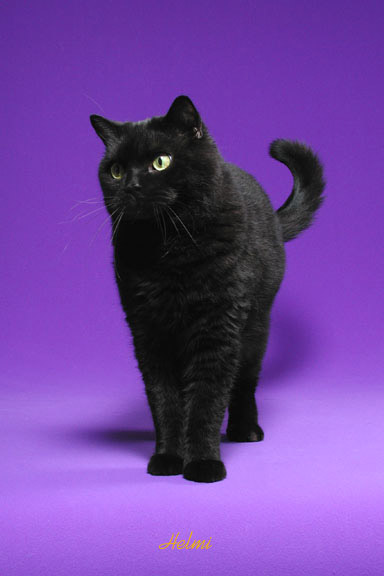
Copyright © Helmi Flick
HF: While we do have a small (too small) studio setup in our home where we occasionally arrange photo sessions by appointment, well over 90% of our work is done on location and almost all of that is at cat shows. Our reason for working this way is much the same as that quote attributed to the notorious bank robber of the 1930s and 40s, Willie Sutton. When he was apprehended and asked by a reporter why he robbed banks, it’s said that Willie replied, “Because that’s where the money is.” Well, in our case, that’s where the cats are, or certainly the largest concentration of the kind of cats we want to photograph. Specifically, our ideal subjects are healthy, well-groomed kitties in prime condition and, equally important, those who are at ease with being handled by strangers. We also want to shoot as a wide variety of breeds as well as coat colors and patterns as possible. And there is no more target-rich an environment for this than a cat show, which is essentially a beauty contest.
JM: Can you describe your lighting set-up when you are on location? How is it different from when you are doing work in studio?
HF: Our lighting setup is the same, whether we’re working at a cat show or in our studio at home. We use a four light setup. Our key light uses a small soft box and is placed at 90 degrees from the cat and at about a 45 degree downward angle. It is flagged so none of its light spills onto our background subject. We place our fill light, which uses a larger soft box, directly in front of the cat. It is suspended on the crossbar of a background stand so that it’s above the camera and shining down on the cat from about 30 degrees above. Our back light uses a 20-degree spot grid and is angled slightly downward on the cat from its position alongside and behind our background. Our background light is a small battery powered slave flash, which is hidden behind an elevated deck where the cat is positioned. The deck keeps our subjects in a controllable plane of focus. Except for our little background light, all of our flashes are Alien Bees, which we enthusiastically recommend for their economy, flexibility, portability, and reliability.
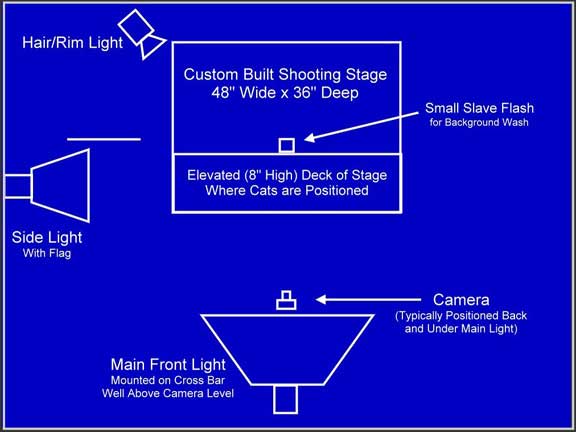
Copyright © Helmi Flick
JM: How are you using the light?
HF: If it would help to convey our lighting array, we could say that for an overhead (plan) view of our setup, envision a clock face with the subject (cat) at the center of the dial (or axis of the hands) and the photographer at 6 o’clock. Our fill light is also at 6 o’clock, above the camera. Our key light would be at 3 or 9 o’clock. Perhaps not as ideal for subject illumination as 4 or 8 o’clock would be, but we do not want any key light on our background. Our back light or hair light is placed at around 1:30 or 10:30. And our background light would be just above the axis of the hands and facing 12 o’clock.
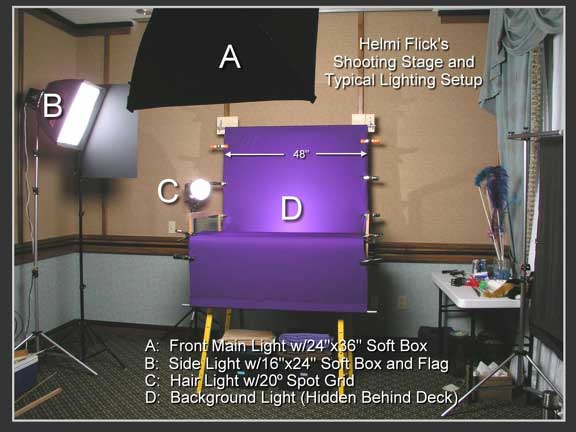
Copyright © Helmi Flick
JM: What special preparations do you take prior to a shoot? What 'must haves' do you bring with you?
HF: To summon up the equanimity required to photograph cats, prior to a shoot we meditate at length while listening to whale song. Just kidding. But we do have to work at maintaining an easy-going frame of mind -- both toward the cat and each other – since eliciting the cooperation of these blissfully uncooperative creatures can sometimes demand saintly levels of patience.
We bring cat teases, visible and audible, for wrangling and getting the cat’s attention. Ken’s favorite visible cat tease is a long pheasant feather taped to a dowel rod. Some of the audible teases we use are squirrel calls, squeeze toys (rubber ducky), clickers, and a toy train whistle.
JM: Working with cats is notoriously difficult. How have you been able to develop a career shooting them? Do you use any special techniques when photographing them?
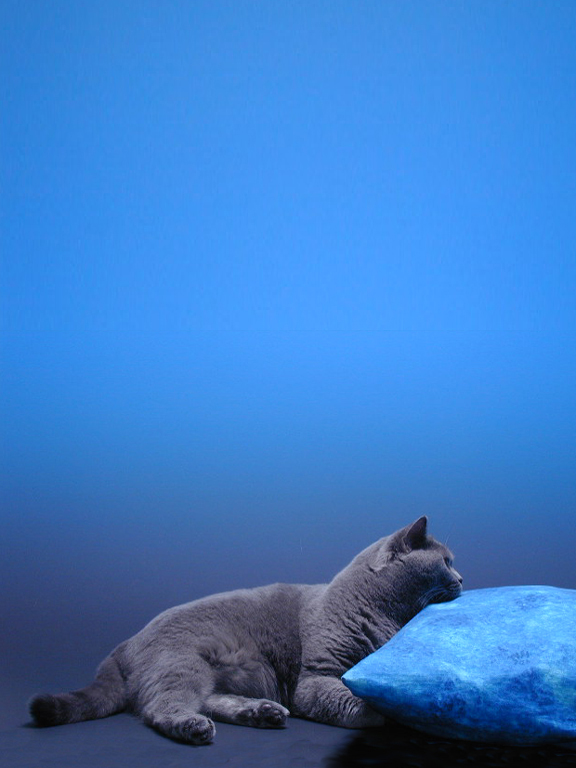
Copyright © Helmi Flick
HF: Photographing dogs, on those infrequent occasions when we have agreed to do this – always at the request of one of our cat-owning customers – is a far easier task. It helps immeasurably when your subject, by its nature, is both obedient and eager to please. Yet, while we enjoy the company of some dogs, generally the larger, mellower breeds, we prefer dealing with cats. Clearly, not because they are easier subjects but simply because we are “cat people” and we have a special resonance with felines that is just not there for us with dogs. That makes us more willing to accept the considerable challenges of cat portraiture and more tolerant of the cat’s often oblivious level of participation in the process.
We’re committed, and exclusively devoted to this unlikely niche of the photography business, not because “that’s where the money is,” but because we love cats and we want to create images that communicate this adoration to those who see our photos. Images that, hopefully, will justify our love of cats and infect others with it. We feel that our feline subjects can sense our special affinity for them by the way we touch them and talk to them during a shoot (and even “think” to them) and as a result, they are a bit more prone to perform for those who appreciate their elegance and beauty.
You can view more of Helmi Flick's work at www.webphotoforum.com/artist.asp?aID=1677
You can also visit her home page at www.helmiflick.com
You may also view more of Helmi's images here: 

As always, we encourage you to come join the community and to be participants in the forums! If you have not registered yet, please
 |
 |
 |
 |